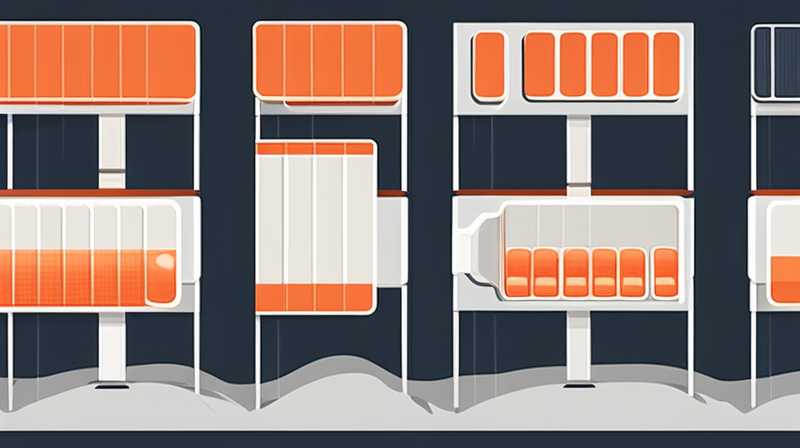
To connect aluminum tubes for solar installation, 1. precise measurement is essential, 2. selection of appropriate connectors must be made, 3. careful preparation of surfaces is critical, and 4. secure fastening ensures durability.
1. PRECISE MEASUREMENT
Successful solar installation demands accurate measurement of aluminum tubes. Measurement begins with identifying the required lengths to fit the specific design of the solar setup. Before cutting, consider the layout of the solar panels, including tilt angles, spacing, and orientation to maximize sunlight exposure. Utilizing a measuring tape, mark each section clearly, ensuring all tubes correspond to the intended dimensions.
For maximum effectiveness, utilize saws suited for aluminum cutting, which reduce burrs and splintering, allowing for cleaner edges. Cut aluminum tubes with precision to avoid wasting materials and ensure compatibility with connectors. Ideally, measurements should be recorded multiple times to mitigate errors, which can result in significant challenges during installation.
2. SELECTION OF APPROPRIATE CONNECTORS
Once the aluminum tubes are cut, the choice of connectors becomes paramount. Various connector types are available, including corner brackets, tee connectors, and flexible joints. Each option should be analyzed concerning the project’s environmental settings and structural demands. For instance, in locations subject to high winds, stronger, rigid connectors may be preferable, while in calmer settings, lighter options can suffice.
Furthermore, evaluate the materials and strengths of the connectors. High-quality connectors made from corrosion-resistant materials can greatly enhance longevity. They should also accommodate any thermal expansion that aluminum may experience during temperature fluctuations. Proper selection ensures structural integrity and facilitates ease of assembly during installation.
3. CAREFUL PREPARATION OF SURFACES
Before connecting the aluminum tubes, surface preparation plays a pivotal role. To ensure reliable connections, clean all surfaces thoroughly. Remove any grease, dust, or oxidation for adequate bonding. Utilizing fine-grit sandpaper can smooth edges and surfaces, promoting better contact between fittings and tubes.
In addition to cleaning, applying protective coatings can enhance durability. Consider using anodization on aluminum tubes to prevent corrosion and to extend the lifespan of the installation. This treatment will create a protective oxide layer that resists environmental wear and tear, considerably increasing the longevity of the solar installation.
4. SECURE FASTENING ENSURES DURABILITY
After preparing the tubes and selecting the right connectors, fastening becomes a decisive factor in reducing fatigue in joints. Employ suitable fastening techniques based on the type of connection. For instance, screws may provide a more permanent bond otherwise retained by bolts and brackets for modular designs.
Moreover, follow recommended torque specifications during fastening to prevent over-tightening, which can compromise the structural integrity of the aluminum. Regular inspections post-installation should be performed to ensure no connections have loosened over time, as this can affect the overall performance of the solar system. Properly secured connections will withstand environmental influences, ensuring uninterrupted functionality.
FREQUENTLY ASKED QUESTIONS
WHAT TOOLS ARE REQUIRED FOR ALUMINUM TUBE CONNECTION IN SOLAR INSTALLATION?
Essential tools include measuring tape, cutting saws specifically designed for metal, sanding equipment, and fastening tools such as screwdrivers or wrenches. A measuring tape is critical for obtaining accurate lengths, crucial for cutting the aluminum tubes. Cutting saws must feature fine teeth to minimize burrs and ensure clean cuts. Sanding equipment is beneficial for preparing surfaces, while manual or power fastening tools will facilitate quick and accurate assembly. Additionally, safety gear, including gloves and goggles, is advisable to prevent injuries during the cutting and assembly processes.
HOW DO ENVIRONMENTAL CONDITIONS AFFECT ALUMINUM CONNECTIONS IN SOLAR INSTALLATIONS?
Environmental factors like humidity, temperature variances, and exposure to UV rays can significantly impact aluminum connections. In humid conditions, moisture may induce corrosion over time, necessitating the use of anodized or coated aluminum. Furthermore, ultraviolet radiation from sunlight may weaken certain adhesives or materials used in connectors, reducing their viability and lifespan. Adjustments may include reinforcing connections in areas with pronounced temperature fluctuations, as aluminum expands and contracts, which can cause stress on joints. Understanding these conditions allows for proper material selection and installation practices that can withstand regional environmental challenges.
CAN I REUSE ALUMINUM TUBES FOR DIFFERENT SOLAR INSTALLATION PROJECTS?
Reusability depends on the condition of the aluminum tubes and the specifics of the new project. If the tubes have been properly maintained and cleaned, they can often be used for new installations, provided that they meet the current project’s structural requirements. Inspecting them for any deformities or corrosion ensures they remain functional. Care should be taken to clean any wells left from previous fastenings, as these may affect new connections. Furthermore, evaluation of the new setup’s design is crucial to confirm compatibility with the re-used tubes. Adapting materials sustainably maximizes resources and promotes environmentally friendly practices.
5. FINAL THOUGHTS ON ALUMINUM TUBE CONNECTIONS
Connecting aluminum tubes for solar installation requires meticulous planning and execution. Each stage—from initial measurements to choosing the best connectors and ensuring secure fastening—can have profound effects on the overall performance of the solar system. Errors at any level can lead to compromised structures, impacting efficiency and longevity.
To ensure a high level of professionalism in the approach, begin with accurate measurements, followed by a careful selection of high-quality components and connectors. This deliberation enhances the structural integrity and functionality of the installation. Proper preparation will minimize future maintenance and extend the life of the solar system.
Lastly, regular checks will pinpoint any issues that might arise over time, serving as a proactive measure to uphold the installation’s value and efficiency. In modern solar implementation projects, it is crucial to prioritize quality connections and best practices for securing that the energy harnessed is utilized effectively.
In sum, emphasizing details at each phase ultimately translates into enhanced performance and sustainability of solar installations utilizing aluminum tubes. In an era increasingly focused on renewable energy solutions, mastering these connection techniques stands as a vital skill for engineers and DIY enthusiasts alike.
Original article by NenPower, If reposted, please credit the source: https://nenpower.com/blog/how-to-connect-the-aluminum-tube-for-solar-installation/


